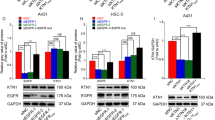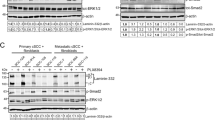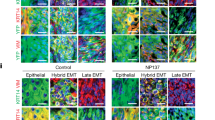Abstract
E-cadherin, a cell–cell adhesion glycoprotein, is frequently downregulated with tumorigenic progression. The extracellular domain of E-cadherin is cleaved by proteases to generate a soluble ectodomain fragment, termed sEcad, which is elevated in the urine or serum of cancer patients. In this study, we explored the functional role of sEcad in the progression of skin squamous cell carcinomas (SCCs). We found that full-length E-cadherin expression was decreased and sEcad increased in human clinical tumor samples as well as in ultraviolet (UV)-induced SCCs in mice. Interestingly, sEcad associated with members of the human epidermal growth factor receptor (HER) and insulin-like growth factor-1 (IGF-1R) family of receptors in human and UV-induced mouse tumors. Moreover, in both E-cadherin-positive (E-cadherin+) and -negative (E-cadherin−) cells in vitro, sEcad activated downstream mitogen-activated protein (MAP) kinase (MAPK) and phosphatidylinositol 3-kinase (PI3K)/Akt/mammalian target of rapamycin (mTOR) signaling and enhanced tumor growth, motility and invasion, the latter via activation of matrix metalloproteinase-2 (MMP-2) and MMP-9. To this end, HER, PI3K or MEK inhibitors suppressed sEcad’s tumorigenic effects, including proliferation, migration and invasion. Taken together, our data suggest that sEcad contributes to skin carcinogenesis via association with the HER/IGF-1R-family of receptors and subsequent activation of the MAPK and PI3K/Akt/mTOR pathways, thereby implicating sEcad as a putative therapeutic target in cutaneous SCCs.
This is a preview of subscription content, access via your institution
Access options
Subscribe to this journal
Receive 50 print issues and online access
$259.00 per year
only $5.18 per issue
Buy this article
- Purchase on Springer Link
- Instant access to full article PDF
Prices may be subject to local taxes which are calculated during checkout







Similar content being viewed by others
References
Gamallo C, Palacios J, Suarez A, Pizarro A, Navarro P, Quintanilla M et al. Correlation of E-cadherin expression with differentiation grade and histological type in breast carcinoma. Am J Pathol 1993; 142: 987–993.
Mayer B, Johnson JP, Leitl F, Jauch KW, Heiss MM, Schildberg FW et al. E-cadherin expression in primary and metastatic gastric cancer: down-regulation correlates with cellular dedifferentiation and glandular disintegration. Cancer Res 1993; 53: 1690–1695.
Brouxhon S, Kyrkanides S, O’Banion MK, Johnson R, Pearce DA, Centola GM et al. Sequential down-regulation of E-cadherin with squamous cell carcinoma progression: loss of E-cadherin via a prostaglandin E2-EP2 dependent posttranslational mechanism. Cancer Res 2007; 67: 7654–7664.
Cavallaro U, Christofori G . Cell adhesion and signaling by cadherins and Ig-CAMs in cancer. Nat Rev Cancer 2004; 4: 118–132.
Margulis A, Zhang W, Alt-Holland A, Crawford HC, Fusenig NE, Garlick JA . E-cadherin suppression accelerates squamous cell carcinoma progression in three-dimensional, human tissue constructs. Cancer Res 2005; 65: 1783–1791.
Maretzky T, Reiss K, Ludwig A, Buchholz J, Scholz F, Proksch E et al. ADAM10 mediates E-cadherin shedding and regulates epithelial cell–cell adhesion, migration, and beta-catenin translocation. Proc Natl Acad Sci USA 2005; 102: 9182–9187.
Kuefer R, Hofer MD, Gschwend JE, Pienta KJ, Sanda MG, Chinnajyan AM et al. The role of an 80 kDa fragment of E-cadherin in the metastatic progression of prostate cancer. Clin Cancer Res 2003; 9: 6447–6452.
Chan AO, Chu KM, Lam SK, Wong BC, Kwok KF, Law S et al. Soluble E-cadherin is an independent pretherapeutic factor for long-term survival in gastric cancer. J Clin Oncol 2003; 21: 2288–2293.
Katayama M, Hirai S, Kamihagi K, Nakagawa K, Yasumoto M, Kato I . Soluble E-cadherin fragments increased in circulation of cancer patients. Br J Cancer 1994; 69: 580–585.
Davies G, Jiang WG, Mason MD . Matrilysin mediates extracellular cleavage of E-cadherin from prostate cancer cells: a key mechanism in hepatocyte growth factor/scatter factor-induced cell-cell dissociation and in vitro invasion. Clin Cancer Res 2001; 7: 3289–3297.
Nawrocki-Raby B, Gilles C, Polette M, Bruyneel E, Laronze JY, Bonnet N et al. Upregulation of MMPs by soluble E-cadherin in human lung tumor cells. Int J Cancer 2003; 105: 790–795.
Symowicz J, Adley BP, Gleason KJ, Johnson JJ, Ghosh S, Fishman DA et al. Engagement of collagen-binding integrins promotes matrix metalloproteinase-9-dependent E-cadherin ectodomain shedding in ovarian carcinoma cells. Cancer Res 2007; 67: 2030–2039.
Bol D, Kiguchi K, Gimenez-Conti I, Rupp T, DiGiovanni J . Overexpression of insulin-like growth factor-1 induces hyperplasia, dermal abnormalities, and spontaneous tumor formation in transgenic mice. Oncogene 1997; 14: 1725–1734.
El-Abaseri TB, Putta S, Hansen LA . Ultraviolet irradiation induces keratinocyte proliferation and epidermal hyperplasia through the activation of the epidermal growth factor receptor. Carcinogenesis 2006; 27: 225–231.
Madson JG, Hansen LA . Multiple mechanisms of Erbb2 action after ultraviolet irradiation of the skin. Mol Carcinog 2007; 4: 624–628.
Wan YS, Wang ZQ, Shao Y, Voorhees JJ, Fisher GJ . Ultraviolet irradiation activates PI 3-kinase/AKT survival pathway via EGF receptors in human skin in vivo. Int J Oncol 2001; 18: 461–466.
Wilker E, Lu J, Rho O, Carbajal S, Beltrán L, DiGiovanni J . Role of PI3K/Akt signaling in insulin-like growth factor-1 (IGF-1) skin tumor promotion. Mol Carcinog 2005; 44: 137–145.
Hynes NE, Lane HA . ERBB receptors and cancer: the complexity of targeted inhibitors. Nat Rev Cancer 2005; 5: 341–354.
Dlugosz AA, Hansen L, Cheng C, Alexander N, Denning MF, Threadgill DW et al. Targeted disruption of the epidermal growth factor receptor impairs growth of squamous papillomas expressing the v-ras(Ha) oncogene but does not block in vitro keratinocyte responses to oncogenic ras. Cancer Res 1997; 57: 3180–3188.
El-Abaseri TB, Fuhrman J, Trempus C, Shendrik I, Tennant RW, Hansen LA . Chemoprevention of UV light-induced skin tumorigenesis by inhibition of the epidermal growth factor receptor. Cancer Res 2005; 65: 3958–3965.
Vassar R, Fuchs E . Transgenic mice provide new insights into the role of TGF-alpha during epidermal development and differentiation. Genes Dev 1991; 5: 714–727.
Bol D, Kiguchi K, Beltrán L, Rupp T, Moats S, Gimenez-Conti I et al. Severe follicular hyperplasia and spontaneous papilloma formation in transgenic mice expressing the neu oncogene under the control of the bovine keratin 5 promoter. Mol Carcinog 1998; 21: 2–12.
DiGiovanni J, Bol DK, Wilker E, Beltrán L, Carbajal S, Moats S et al. Constitutive expression of insulin-like growth factor-1 in epidermal basal cells of transgenic mice leads to spontaneous tumor promotion. Cancer Res 2000; 60: 1561–1570.
Galer CE, Corey CL, Wang Z, Younes MN, Gomez-Rivera F, Jasser SA et al. Dual inhibition of epidermal growth factor receptor and insulin-like growth factor receptor I: reduction of angiogenesis and tumor growth in cutaneous squamous cell carcinoma. Head Neck 2011; 33: 189–198.
Najy AJ, Day KC, Day ML . The ectodomain shedding of E-cadherin by ADAM15 supports ErbB receptor activation. J Biol Chem 2008; 283: 18393–18401.
Inge LJ, Barwe SP, D’Ambrosio J, Gopal J, Lu K, Ryazantsev S et al. Soluble E-cadherin promotes cell survival by activating epidermal growth factor receptor. Exp Cell Res 2011; 317: 838–848.
Kim AL, Athar M, Bickers DR, Gautier J . Stage-specific alterations of cyclin expression during UVB-induced murine skin tumor development. Photochem Photobiol 2002; 75: 58–67.
Moll R, Mitze M, Frixen UH, Birchmeier W . Differential loss of E-cadherin expression in infiltrating ductal and lobular breast carcinomas. Am J Pathol 1993; 143: 1731–1742.
Takeichi M . Cadherins in cancer: implications for invasion and metastasis. Curr Opin Cell Biol 1993; 5: 806–811.
Batistatou A, Charalabopoulos AK, Scopa CD, Nakanishi Y, Kappas A, Hirohashi S et al. Expression patterns of dysadherin and E-cadherin in lymph node metastases of colorectal carcinoma. Virchows Arch 2006; 448: 763–767.
Bongiorno PF, al-Kasspooles M, Lee SW, Rachwal WJ, Moore JH, Whyte RI et al. E-cadherin expression in primary and metastatic thoracic neoplasms and in Barrett's oesophagus. Br J Cancer 1995; 71: 166–172.
Saha B, Chaiwun B, Imam SS, Tsao-Wei DD, Groshen S, Naritoku WY et al. Overexpression of E-cadherin protein in metastatic breast cancer cells in bone. Anticancer Res 2007; 27: 3903–3908.
Yang J, Dai DQ . A comparative study of E-cadherin mRNA expression in primary tumors and metastatic foci of gastric cancer. Zhonghua Zhong Liu Za Zhi 2005; 27: 25–28.
Fujii K, Furukawa F, Matsuyoshi N . Ligand activation of overexpressed epidermal growth factor receptor results in colony dissociation and disturbed E-cadherin function in HSC-1 human cutaneous squamous carcinoma cells. Exp Cell Res 1996; 223: 50–62.
Hazan RB, Norton L . The epidermal growth factor receptor modulates the interaction of E-cadherin with the actin cytoskeleton. J Biol Chem 1998; 273: 9078–9084.
Wilding J, Vousden KH, Soutter WP, McCrea PD, Del Buono R, Pignatelli M . E-cadherin transfection down-regulates the epidermal growth factor receptor and reverses the invasive phenotype of human papilloma virus-transfected keratinocytes. Cancer Res 1996; 56: 5285–5292.
Nahta R, Yuan LX, Zhang B, Kobayashi R, Esteva FJ . Insulin-like growth factor-I receptor/human epidermal growth factor receptor 2 heterodimerization contributes to trastuzumab resistance of breast cancer cells. Cancer Res 2005; 65: 11118–11128.
Higgins MJ, Baselga J . Targeted therapies for breast cancer. J Clin Invest 2011; 121: 3797–3803.
Bjornsti MA, Houghton PJ . The TOR pathway: a target for cancer therapy. Nat Rev Cancer 2004; 4: 335–348.
Hay N, Sonenberg N . Upstream and downstream of mTOR. Genes Dev 2004; 18: 1926–1945.
Esch TR, Jonsson MV, Levanos VA, Poveromo JD, Sorkin BC . Leukocytes infiltrating the submandibular glands of NOD mice express E-cadherin. J Autoimmun 2000; 15: 387–393.
Fong KP, Barry C, Tran AN, Traxler EA, Wannemacher KM, Tang HY . Deciphering the human platelet sheddome. Blood 2011; 117: e15–e26.
Uchida Y, Kawai K, Ibusuki A, Kanekura T . Role for E-cadherin as an inhibitory receptor on epidermal gamma delta T cells. J Immunol 2011; 186: 6945–6954.
Van den Bossche J, Malissen B, Mantovani A, De Baetselier P, Van Ginderachter JA . Regulation and function of the E-cadherin/catenin complex in cells of the monocyte-macrophage lineage and DCs. Blood 2012; 119: 1623–1633.
Maretzky T, Scholz F, Köten B, Proksch E, Saftig P, Reiss K . ADAM10-mediated E-cadherin release is regulated by proinflammatory cytokines and modulates keratinocyte cohesion in eczematous dermatitis. J Invest Dermatol 2008; 128: 1737–1746.
Rheinwald JG, Green H . Serial cultivation of strains of human epidermal keratinocytes: the formation of keratinizing colonies from single cells. Cell 1975; 6: 331–344.
Kyrkanides S, Miller JH, Tallents R, Brouxhon S, Centola G, Olschowka J . Intraperitoneal inoculation of Sandhoff mouse neonates with an HIV-1 based lentiviral vector exacerbates the attendant neuroinflammation and disease phenotype. J Neuroimmunol 2007; 188: 39–47.
Acknowledgements
We thank Dr Yuspa (NCI) and Dr Klein-Szanto (Fox Chase Cancer Center) for the PAM212 and CC4A cells, respectively. This work was supported by NIH grants K08CA133910 (NCI) and R21ES015832 (NIEHS) to SMB as well as NIH grant R01CA138998 (NCI) to MA.
Author information
Authors and Affiliations
Corresponding author
Ethics declarations
Competing interests
The authors declare no conflict of interest.
Rights and permissions
About this article
Cite this article
Brouxhon, S., Kyrkanides, S., Teng, X. et al. Soluble E-cadherin: a critical oncogene modulating receptor tyrosine kinases, MAPK and PI3K/Akt/mTOR signaling. Oncogene 33, 225–235 (2014). https://doi.org/10.1038/onc.2012.563
Received:
Revised:
Accepted:
Published:
Issue Date:
DOI: https://doi.org/10.1038/onc.2012.563
Keywords
This article is cited by
-
Long-term epilepsy-associated tumors: transcriptional signatures reflect clinical course
Scientific Reports (2020)
-
sEcad and EGF Levels Increased in Urine of Non-ferrous Metal Workers and Medium of Uroepithelial Cell Line Treated by Arsenic
Biological Trace Element Research (2018)
-
Gefitinib inhibits M2-like polarization of tumor-associated macrophages in Lewis lung cancer by targeting the STAT6 signaling pathway
Acta Pharmacologica Sinica (2017)
-
E-cadherin genetic variants predict survival outcome in breast cancer patients
Journal of Translational Medicine (2016)
-
Relation of dietary inorganic arsenic to serum matrix metalloproteinase-9 (MMP-9) at different threshold concentrations of tap water arsenic
Journal of Exposure Science & Environmental Epidemiology (2016)



